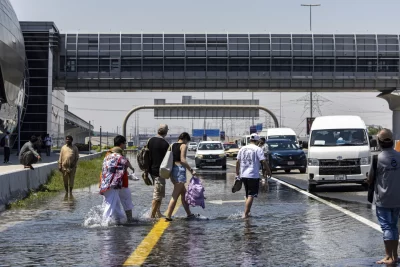
DEERBROOK, Wis— Jeremy Solin doesn’t need a jacket right now on his family farm in northern Wisconsin. There’s no snow blanketing the dead leaves in the grove of sugar maples. There, pails already hang beneath spiles in the trunks that have started dripping sap. And the ground is muddy — a sign of the spring thaw.
But the timing is all off. “It’s just very disorienting,” he said. He isn’t the only maple syrup producer feeling this way. In many parts of Wisconsin and the Midwest this year, the warmest winter on record drove farmers and hobbyists alike to start collecting tree sap for maple syrup a month or more earlier than they normally would.
Experts say that the shift in maple syrup season could be one clear indicator of the ways climate change is affecting trees, but they also think the practice serves as an important motivation to preserve forests. Producers have deeply personal ties to their land, whether they are Indigenous producers serving their community or have family-run operations and want to leave a legacy for the next generation. That relationship between people and their maple trees may ultimately make people more willing to adapt and be resilient in the face of seasonal changes.“Maple trees have sustained humans for centuries,” said Eli Suzukovich III, an assistant professor of instruction at Northwestern University who teaches a class on maple syrup and climate change. “Now maybe it’s just our turn to return the favor.”
A PROCESS THAT RELIES ON THE SEASONS
With the arrival of spring, maple trees start to “wake up” from the dormant state that keeps them alive through the winter. But during the critical few weeks of early spring where it’s above freezing during the day and below freezing at night, the trees use their sugar in sap as a kind of antifreeze. Humans have been taking advantage of that process for millennia, collecting the clear, watery sap that flows in early spring and boiling it down to condense it into maple syrup or maple sugar.
But timing is everything. Tapping the trees too soon, especially with the spile-and-bucket method, doesn’t work, because the holes start to close up after a few weeks. The more common commercial method, which involves a series of plastic tubing often called “lines” that snake from tree to tree and ferry the sap in huge quantities, is a bit more forgiving of tapping early but still requires strategic planning.
This year’s warmer winter temperatures have allowed some maple syrup producers across the U.S. to begin tapping trees as much as two months early. In Wisconsin, many farmers started production earlier than they can ever remember doing it.
That’s why producers were caught by surprise this year — they typically plan for mid-March or April, but as they checked the weather this unprecedentedly warm January, they realized the sap had already started flowing. About 40 miles away from Solin, syrup producers missed the first run of sap on Bodwéwadmi Ktëgan, the farm of the Forest County Potawatomi tribe. Joe Shepard, the assistant farm manager there who’s lived in northern Wisconsin his whole life, said he can’t remember a winter like this, with no snow.
Neither can Karl Martin, dean of University of Wisconsin-Madison’s Division of Extension. Martin’s family taps about 4,500 trees, and this year they lost out on about 25% of their production.







